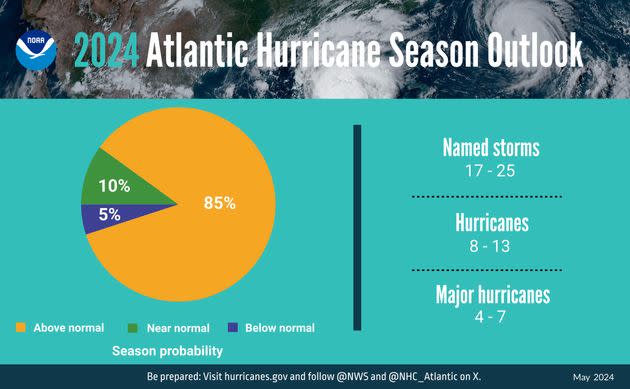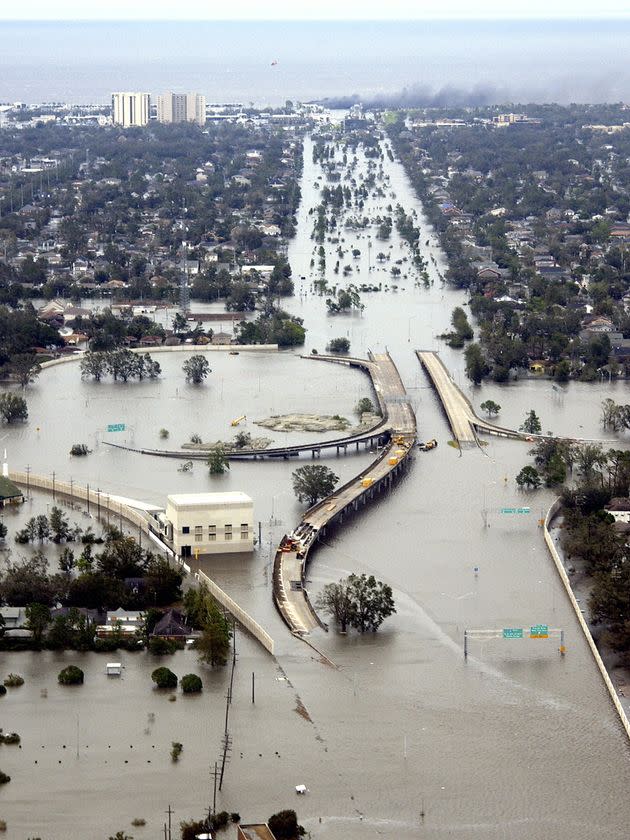NOAA Issues Its Most Aggressive Storm Forecast Yet Ahead Of Hurricane Season

This year’s hurricane season in the Atlantic is expected to be among the worst in decades, the U.S. government’s weather agency warned Thursday.
Meteorologists with the National Oceanic and Atmospheric Administration are forecasting an 85% chance of an above-normal season, with four to seven major hurricanes — storms producing winds of 111 mph or more — predicted to develop over the next six months.
“The forecast for named storms, hurricanes, and major hurricanes is the highest NOAA has ever issued for the May outlook,” Rick Spinrad, the agency’s administrator, said in a news conference.
In total, the agency expects 17 to 25 storms strong enough to be named, including eight to 13 hurricanes and four to seven major hurricanes. NOAA said its forecasters have a 70% confidence in these ranges.
The forecast is similar to those made by other meteorologists.
Researchers at Colorado State University last month said they anticipate 23 named storms — and of them, 11 hurricanes, five of which will reach major hurricane strength. AccuWeather’s meteorologists said they expect 20-25 named storms, including eight to 12 hurricanes and of them, four to seven major hurricanes.
Climate scientists at the University of Pennsylvania have warned of even more dire conditions, estimating a record 33 named storms will occur this season.
Among other reasons, researchers have cited the near-record high ocean temperatures in the Atlantic, resulting from La Niña conditions in the Pacific, as responsible for the heightened storm conditions. Reduced Atlantic trade winds and less wind shear, also effects of La Niña, are also expected to increase the chances that hurricanes and tropical storms will form.
NOAA also pointed to climate change as one cause of the worsening predictions.
“Human-caused climate change is warming our ocean globally and in the Atlantic basin, and melting ice on land, leading to sea level rise, which increases the risk of storm surge. Sea level rise represents a clear human influence on the damage potential from a given hurricane,” NOAA said in a release.
Hurricane seasons have generally only intensified since the mid-90s. Roughly 70% of the hurricane seasons since 1995 have had above-normal activity, and only 17% have had near-normal activity and 14% below-normal activity, NOAA reported.
“The 2024 North Atlantic hurricane season could be the eighth out of the last 10 with above-average activity,” NOAA said in a press release.
One of the worst recent hurricane seasons was 2017, which saw a record three hurricanes of at least Category 4 strength make landfall on U.S. territory — Harvey in Texas, Irma in the Florida Keys and Maria in Puerto Rico.
NOAA’s predictions for that year had been only slightly off. The agency had forecast 11-17 named storms, five to nine hurricanes, and two to four major hurricanes. It saw 17 named storms, 10 hurricanes, and six major hurricanes.

NOAA’s predictions for 2005 — a season that produced Hurricane Katrina and set a massive number of records at the time — were significantly more optimistic than what the season actually saw, with the number of tropical storms being nearly double of what was predicted. Its predictions for that year were milder than what the agency is expecting in 2024.
More recently, the 2023 Atlantic hurricane season was the fourth-busiest on record for named storms, though Hurricane Idalia was the only one to make landfall.
The North Atlantic hurricane season officially runs from June 1 through November 20. NOAA said it will give another update in early August, which is just before hurricane season historically peaks.

